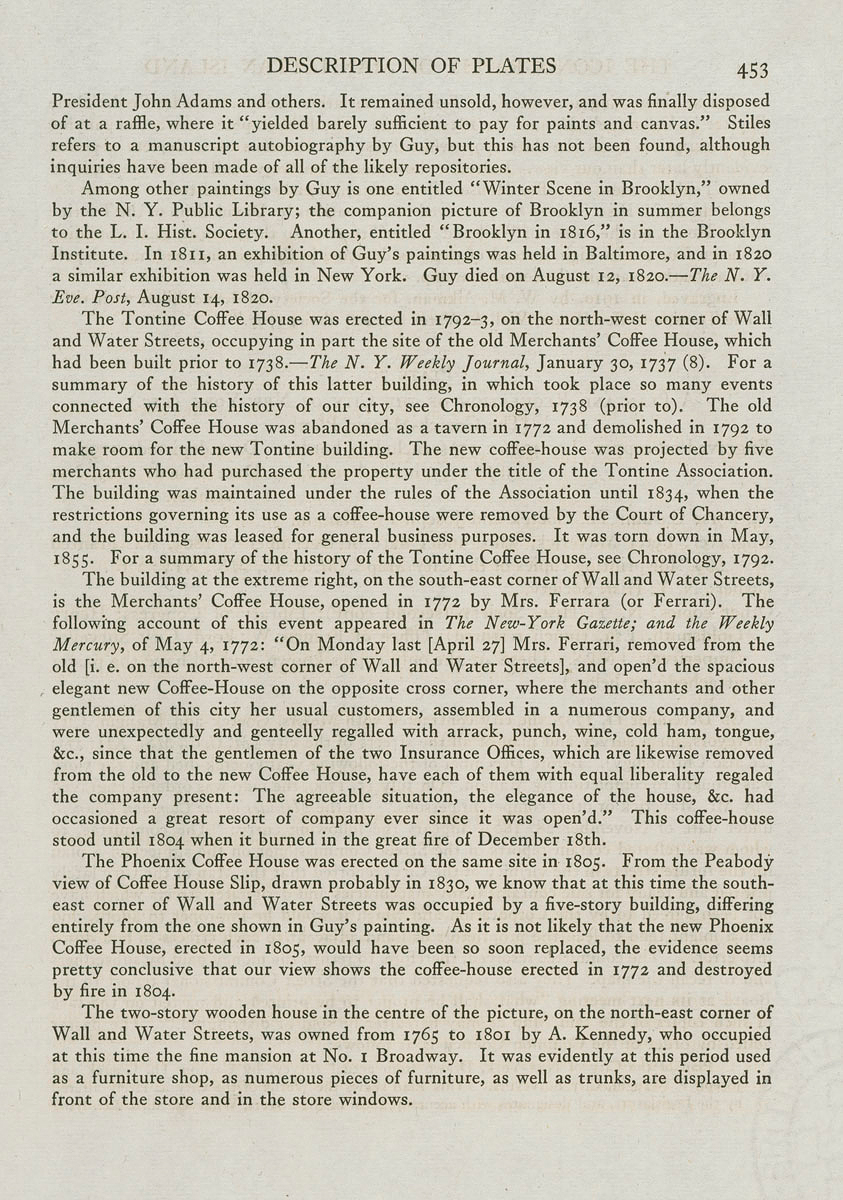DESCRIPTION OF PLATES 453
President John Adams and others. It remained unsold, however, and was finally disposed
of at a raffle, where it "yielded barely sufficient to pay for paints and canvas." Stiles
refers to a manuscript autobiography by Guy, but this has not been found, although
inquiries have been made of all of the likely repositories.
Among other paintings by Guy is one entitled "Winter Scene In Brooklyn," owned
by the N. Y. Public Library; the companion picture of Brooklyn in summer belongs
to the L. I. Hist. Society. Another, entitled "Brooklyn in 1816," is in the Brooklyn
Institute. In 1811, an exhibition of Guy's paintings was held in Baltimore, and in 1820
a similar exhibition was held in New York. Guy died on August 12, 1820.—The N. Y.
Eve. Post, August 14, 1820.
The Tontine Coffee House was erected in 1792-3, on the north-west corner of Wall
and Water Streets, occupying in part the site of the old Merchants' Coffee House, which
had been built prior to 1738.—The N. Y. Weekly Journal, January 30, 1737 (8). For a
summary of the history of this latter building, in which took place so many events
connected with the history of our city, see Chronology, 1738 (prior to). The old
Merchants' Coffee House was abandoned as a tavern in 1772 and demolished in 1792 to
make room for the new Tontine building. The new coffee-house was projected by five
merchants who had purchased the property under the title of the Tontine Association.
The building was maintained under the rules of the Association until 1834, when the
restrictions governing its use as a coffee-house were removed by the Court of Chancery,
and the building was leased for general business purposes. It was torn down in May,
1855. For a summary of the history of the Tontine Coffee House, see Chronology, 1792.
The building at the extreme right, on the south-east corner of Wall and Water Streets,
is the Merchants' Coffee House, opened in 1772 by Mrs. Ferrara (or Ferrari). The
following account of this event appeared in The New-York Gazette; and the Weekly
Mercury, of May 4, 1772: "On Monday last [April 27] Mrs. Ferrari, removed from the
old [i. e. on the north-west corner of Wall and Water Streets], and open'd the spacious
elegant new Coffee-House on the opposite cross corner, where the merchants and other
gentlemen of this city her usual customers, assembled in a numerous company, and
were unexpectedly and genteelly regalled with arrack, punch, wine, cold ham, tongue,
&c., since that the gentlemen of the two Insurance Offices, which are likewise removed
from the old to the new Coffee House, have each of them with equal liberality regaled
the company present: The agreeable situation, the elegance of the house, &c. had
occasioned a great resort of company ever since it was open'd." This coffee-house
stood until 1804 when it burned in the great fire of December i8th.
The Phoenix Coffee House was erected on the same site in 1805. From the Peabody
view of Coffee House Slip, drawn probably in 1830, we know that at this time the south¬
east corner of Wall and Water Streets was occupied by a five-story building, differing
entirely from the one shown in Guy's painting. As it is not likely that the new Phoenix
Coffee House, erected in 1805, would have been so soon replaced, the evidence seems
pretty conclusive that our view shows the coffee-house erected in 1772 and destroyed
by fire in 1804.
The two-story wooden house in the centre of the picture, on the north-east corner of
Wall and Water Streets, was owned from 1765 to 1801 by A. Kennedy, who occupied
at this time the fine mansion at No. i Broadway. It was evidently at this period used
as a furniture shop, as numerous pieces of furniture, as well as trunks, are displayed in
front of the store and in the store windows.
|








